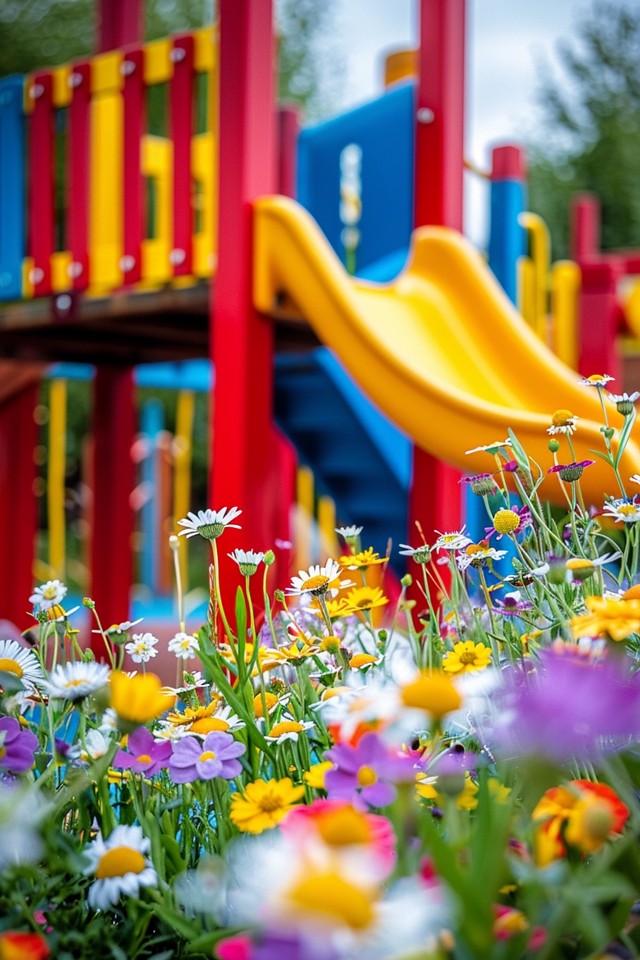Creating a natural playground in your backyard can be an exciting project that encourages active play and sparks joy in children. Natural play spaces provide developmental benefits, allowing kids to explore, learn, and grow in their own imaginative environment. The use of natural materials in playgrounds is not only sustainable but also promotes imaginative play and blends harmoniously with the surrounding landscape. If you’re looking for inspiration, here are some creative playground landscape ideas to transform any outdoor space.
Key Takeaways:
- Creating a natural playground in your backyard promotes active play and sparks joy in children.
- Natural play spaces provide developmental benefits and allow kids to explore, learn, and grow in their own imaginative environment.
- Using natural materials in playgrounds is sustainable and promotes imaginative play that blends harmoniously with the surrounding landscape.
- Consider hiring a landscape architect to seamlessly blend play structures with the natural features of your land.
- Incorporate natural elements like wood, rocks, tree stumps, and sensory gardens to create an inclusive play environment.

Incorporating Natural Elements in Your Playground Design
When designing a natural playground, it’s essential to consider how the structures will fit into the natural features of your land. Hiring a landscape architect can help create a design that seamlessly blends the play structures with the natural landscape.
Natural play areas are often made from organic materials like wood and rocks, which are safer and more environmentally friendly than conventional playground equipment. By incorporating natural elements, you can create a unique and engaging play space that sparks children’s imagination and encourages exploration.
Here are some eco-friendly playground features and natural play space ideas to inspire your playground design:
1. Tree Stumps as Stepping Stones
Use tree stumps as stepping stones to create a challenging and interactive pathway for children to navigate. This not only improves their balance and coordination but also adds a rustic touch to the playground design.
2. Water Tables for Sensory Play
Include water tables in your playground design to provide children with the opportunity for sensory play. These tables allow kids to explore the tactile properties of water while fostering their creativity and imagination.
3. Sensory Gardens
Designate an area for a sensory garden, filled with plants that stimulate multiple senses. Fragrant flowers, textured leaves, and edible herbs can create a sensory-rich environment that captivates children’s senses and encourages exploration.

4. Hanging Tire Swings
Add a touch of adventure to your playground by hanging tire swings from sturdy tree branches. This classic play feature provides hours of swinging fun while blending seamlessly with the natural surroundings.
5. Obstacle Courses
Design an obstacle course using natural materials such as logs, rocks, and tree trunks. These elements create a challenging and engaging play experience while promoting physical fitness and problem-solving skills.
6. Mud Kitchens for Imaginative Play
Set up a mud kitchen in your playground, complete with pots, pans, and utensils. This allows children to engage in imaginative play, “cooking” with mud, and connecting with nature.
By incorporating these natural play space ideas and eco-friendly playground features, you can create an outdoor play area that promotes active play, environmental consciousness, and a deeper connection with nature.

Budget-Friendly Options for Outdoor Play Spaces
Building an outdoor play space doesn’t have to break the bank. By using natural materials found in your own backyard, you can create unique and engaging play structures that stimulate children’s creativity and imagination. Branches, logs, and rocks can be repurposed to build teepees, stepping stone paths, and cozy seating areas. Not only will these structures blend beautifully with the surrounding landscape, but they will also provide endless opportunities for play and exploration.
If you’re looking for affordable materials, yard sales and thrift stores are excellent sources to find hidden gems. Consider picking up old xylophones to create an outdoor music garden or repurpose boats as sandboxes. Salad bowls can easily be transformed into whimsical toadstools. By thinking outside the box and repurposing items, you can add charm and character to your outdoor play area without breaking the bank.
Encouraging open-ended play is another budget-friendly option to create an inclusive and dynamic play environment. Provide children with sticks, rocks, and water, and watch their creativity soar. These simple materials can be used for building forts, creating art, and experimenting with water play. By giving children the freedom to mold their own play spaces, they will develop problem-solving skills, imagination, and a sense of ownership over their play area.
Incorporating sensory play is another way to make your outdoor play space engaging for all children. Repurpose water bottles into sensory bottles filled with colored water, glitter, or small objects. Create sensory tables where children can explore different textures, such as sand, rice, or water. You can also design sensory gardens with plants and flowers that stimulate the senses and provide a multisensory experience for children to enjoy.

